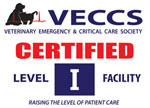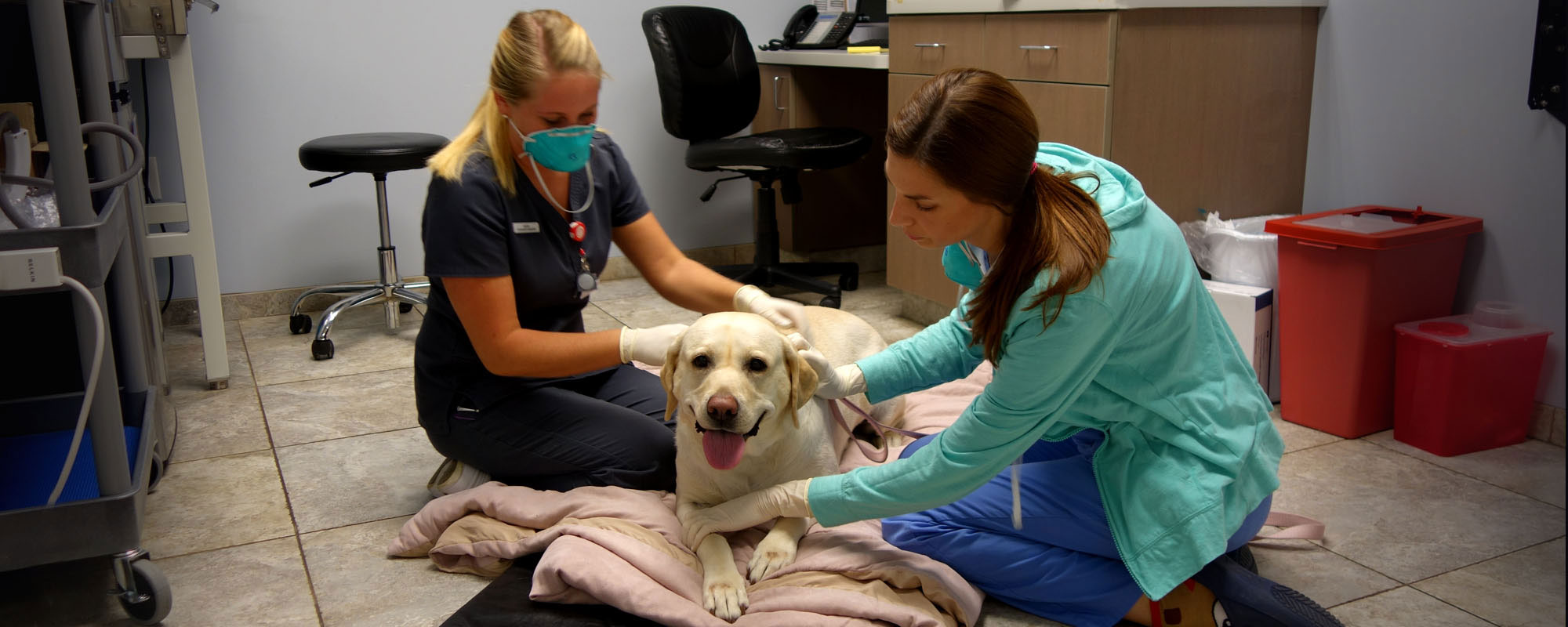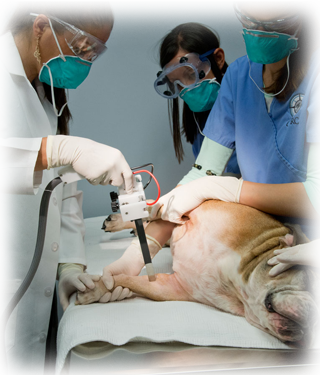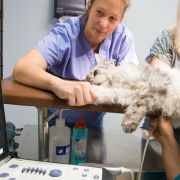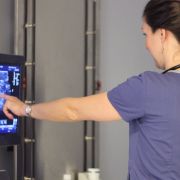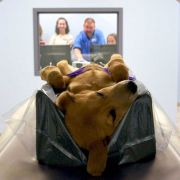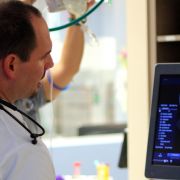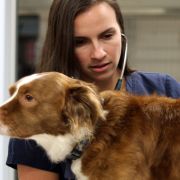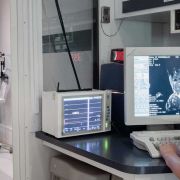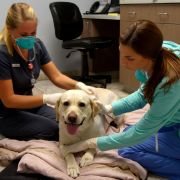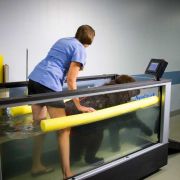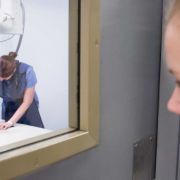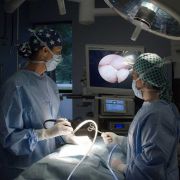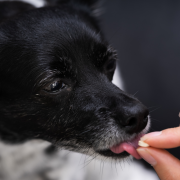A veterinary oncologist is a veterinarian with advanced training and expertise in the diagnosis and treatment of cancer. At CVRC, our oncologist is also trained in the use of ultrasound to help in diagnose and stage your pet's cancer.
A board certified veterinary oncologist is a veterinarian who has obtained intensive, additional training in oncology and has been certified by the American College of Veterinary Internal Medicine (DACVIM-Oncology). The advanced training and education required for this certification includes:
- A veterinary degree (three to four years of undergraduate college, followed by four years of veterinary school).
- One year rotating internship in veterinary medicine and surgery.
- Three years of advanced oncology training (residency).
- A series of rigorous examinations covering all aspects of general internal medicine and veterinary oncology.
Philosophy:
Oncology, the treatment of cancer, involves surgery, chemotherapy, electrochemotherapy, radiation therapy or a combination of these methodologies. Unfortunately, cancer is quite common in our animal companions, with 50% of dogs over age 10 and 1 in 4 of any age developing cancer. Thus, it is crucial for pet owners to be diligent and not take a “wait and see” approach when it comes to lumps and bumps on their pets. If diagnosed early enough, the majority of tumors can be kept in remission for a very long time, or even cured in some cases.
Our goal is not just to prolong life, but to maintain good quality of life, and each visit to CVRC is centered on making sure your pet is still participating in things they love to do (chasing squirrels, playing Frisbee, or taking walks with the family). Chemotherapy in animals is MUCH different than in humans. We use much lower doses of chemotherapeutic drugs and are committed to the idea that the treatment of cancer should NEVER be worse than the cancer itself.
What is an emergency/specialty hospital and how is it different than my primary veterinarian?
A specialty hospital does not offer any routine or preventative care. Our veterinarians have advanced training in specific disciplines such as surgery, oncology, internal medicine, emergency and critical care medicine, physical rehabilitation and neurology among others. We also have equipment that most primary veterinarians don’t have such as CT scans, MRI, endoscopic equipment, and specialized surgical tools. We work closely with your primary veterinarian to offer these services to you.
What services are offered?
Chemotherapy
Chemotherapy is used to treat cancer at the tumor site, as well as the cancer that has potential to spread throughout the body. Most chemotherapeutic drugs act directly on cancer cells, preventing them from maturing or reproducing. Chemotherapy protocols are frequently changed or customized to achieve the best outcome for your pet.
Immunotherapy
Immunotherapy is the use of the body’s immune system to treat a disease. Immunotherapy is used to treat certain cancers. There are various types of immunotherapy ranging from cancer vaccines to injecting cytokines (chemicals that stimulate the body’s own immune system).
Electrochemotherapy is a new treatment option for tumor control that delivers trains of electrical pulses to cancer cells shortly after injection of chemotherapeutic drugs. The pulses open pores in the tumor cell membranes making them more permeable and enabling better penetration of anti-cancer drug molecules to increase tumor cell kill.
Surgery is the oldest form of cancer therapy and has cured more patients than any other treatment method. This great success is mainly due to the development of new surgical techniques combined with chemotherapy and other treatment modalities when indicated, for a comprehensive treatment plan for your pet's cancer. Acupuncture is best used for pets with cancer as a complementary treatment. it won't cure or treat the cancer but it can be used to improve quality of life when used in conjunction with other therapies such as surgery, chemotherapy, and/or radiation therapy.
Acupuncture
Acupuncture stimulates the nervous system and triggers te release of neural hormones such as beta-endrophins, a natural pain supporssor. The process can also reduce pro-inflammatory proeins in the body which helps to decrease inflammation and improve immunity. Acupuncture is best used for pets with cancer as a complementary treatment. It won't cure or treat the cancer but it can be used to improve quality of life when used in conjuction with other therapies such as surgery, chemotherapy, and/or radiation therapy.
Diagnostic Imaging:
- Digital radiography
- Ultrasound
- Fluoroscopy
- CT Scan
- MRI
Full in-house laboratory
- Blood chemistry
- Hematology
- Coagulation profile
- Urinalysis
- Cytology
Full complement of external laboratories for advanced testing
- Histopathology
- Special staining
- Immunocytochemistry
- Immunohistochemistry
- Advanced molecular diagnostics; PARR, Flow Cytometry, various proliferation markers
In-house pharmacy with full complement of oral and injectable medications
Multimodal pain management protocols that help alleviate pain while maintaining quality of life
Fluid therapy and transfusion medicine
Diagnostic Procedures
- Biopsy
- Bone marrow aspirate/biopsy
- Needle aspirate
- Ultrasound guided biopsy/aspirate
- CT guided biopsy/aspirate
What should I expect during my initial oncology visit?
If you are a new client to CVRC, we encourage you to fill out our New Patient Registration Form ahead of time online, or bring the form with you. Otherwise, please arrive to your appointment approximately 10 minutes early to complete this form in our office. If you are transferring for continued care from your primary veterinarian, please come to CVRC at your earliest convenience.
Oncology consultation usually begins with your family veterinarian diagnosing, or being suspicious of, a disease or condition that requires advanced expertise, diagnostics, therapeutics, and patient monitoring. A full history, medical record review, and complete physical examination are performed. After examination and discussion, an initial treatment plan will be presented for the diagnostic workup and/or treatment.
Our oncologist will communicate with you during the work-up or treatment process to keep you informed on your pet's progress. We will also communicate with your primary veterinarian during this process to ensure a collaborative treatment plan for the care of your pet. Upon discharge, you will be given a printed visit summary with the diagnosis, treatment recommendations, and follow up care. A full report will be sent to your family veterinarian the same day. We welcome your progress reports, questions and concerns any time and will maintain an ongoing relationship with your primary care doctor to ensure the best experience for you and the best care for your pet.
What should I bring to my visit?
First and most importantly, bring your pet to all visits. You may be instructed to withhold food and water from midnight the night before your appointment to allow for certain diagnostic testing. If your pet is on any medications, please let us know and we will advise you whether or not to administer them on the morning of your appointment. Also, please bring a list of all medications, strengths and dosages, or the pill vials. Records, including recent laboratory work, can be faxed or emailed to us from your primary care veterinarian prior to the appointment. If your pet has had any x-rays taken recently, please bring those with you as well. We can request records and digital x-rays on your behalf from your family veterinarian once you have scheduled a visit with us.
Do I need a referral?
While referrals are recommended to see one of our specialists, they are not required. It is always better to speak to your veterinarian about a referral so we can collaborate with your veterinarian to ensure the best care for your pet.
Will you keep my family veterinarian informed of the care my pet receives at CVRC?
We work closely with your primary veterinarian and ensure they receive copies of all medical records. We also communicate via phone and they have the ability to access a portal into our medical record system.
Does the oncologist only see pets that have been diagnosed with cancer?
Our oncologist often sees pets that are suspected of having cancer even if a definitive diagnosis has not yet been made. Using imaging modalities, laboratory tests, physical exam findings and procedures we can determine if your pets clinical signs are resulting from cancer.
My pet has cancer. How long will he/she live with treatment?
This answer is highly variable depending on the condition of your pet, type and stage of cancer, any other related medical conditions, and the treatment protocol used. Please schedule an appointment with our oncologist to discuss the options for diagnosis and treatment for your pet. At that time, the oncologist will be able to give you an expectation level of survival time.
What are the common side effects of chemotherapy?
The most common side effect of chemotherapy in our patients is decreased appetite and nausea. These are usually mild, short in duration, and easily controlled with some medications. Occasionally vomiting and diarrhea may occur. Please be in contact with us immediately if your pet is having any side effects so that we can address them and adjust our treatment protocols if necessary. In very rare instances side effects requiring hospitalization and more aggressive therapy may be required.
How many treatments will my pet need?
Depending on the stage and type of cancer, response to treatment, and your pet's overall health condition, this can vary greatly. Our oncologist will provide a detailed treatment protocol to you with the expected duration and frequency of treatments at your appointment.
How long does it take to give chemotherapy?
Usually the visit for chemotherapy takes 30 minutes to 1 hour. The oncologist will perform a full examination at every visit and review laboratory work to ensure your pet can receive treatment. Some medications require a longer time to administer to minimize the side effects to your pet.
Can I drop my pet off for chemotherapy?
We are happy to offer drop off chemotherapy appointments if that works better for your schedule. We also have regularly scheduled appointment times and try to be accommodating of your schedules as much as possible.
How is chemotherapy given?
Injectable drugs are given through a small needle directly into a vein or under the skin and cause no more discomfort to animals than a routine vaccine. Some chemotherapeutic protocols will use oral medications that are given by you at home, or by us in the hospital. For your pet’s safety, we use the Phaseal® system which is the only clinically-proven Closed System Drug Transfer Device (CSTD) that prevents hazardous drug interaction with the environment. This allows quick and safe administration, so your pet can be back home with you as soon as possible.
What is the cost of treatment?
The cost associated with the diagnosis and treatment of your pet's condition varies significantly with the type of cancer as well as the type of treatment. Our oncologist will discuss the costs associated with treatment at the time of your appointment.
Can you cure my pet's cancer?
Some cancers can be cured (depending on the type of cancers), and many can be kept in remission for long periods of time.
What is 'staging' and why is it important?
Cancer staging is the diagnostic process of determining how much cancer is in the body, and where it is located. This is typically done with diagnostic tools like CT Scan, x-ray and ultrasound, as well as a detailed physical examination.
It is important because it tells us if different body areas are affected by the cancer, if it has spread, as well as if our chemotherapy is working effectively.
What is 'metronomic' chemotherapy?
Metronomic chemotherapy is a new way of dosing traditional chemotherapy in our patients for certain types of cancer. It consists of oral drugs compounded into VERY SMALL doses and given at home on a daily basis. The goal of this type of dosing is to target the blood vessels that supply blood and nutrients to the remaining tumor cells (these cells require blood supply and nutrients to regrow). This therapy has minimal side effects.
What precautions do I need to take at home with my pet while he/she is receiving chemotherapy?
Chemotherapy will be present in your pet’s urine up to 21 days. The specifics can vary depending on the specific drugs used and it is highly recommended to take some basic precautions to prevent exposure.
- Any accidental urination in the house should be cleaned up promptly and disposed of in a separate bag.
- Be sure to wear gloves when handling stool or urine clean-ups.
- Keep children and other pets away from areas where accidents have occurred.
- When allowing pet to urinate outside, take to an area which is not visited by other pets or children.
- If accidental skin contact is made with urine, wash skin thoroughly with soap and water.
- Floors can be cleaned by thoroughly washing with a detergent cleanser.
What is electrochemotherapy?
We are very excited to be offering electrochemotherapy (ECT) at Charleston Veterinary Referral Center. Please follow this link for more information about ECT.
What is ultrasound?
Ultrasound is a diagnostic tool used to obtain more detailed information about internal body structures. Ultrasound machines use sound waves administered by a small handheld device called a probe, waves are reflected back to the probe, and a computer formats these into visual pictures on a monitor for the clinician to review. Ultrasound is painless and noninvasive.
Ultrasound is a modality that requires significant training and experience by the clinician to achieve an accurate diagnosis and interpretation of the study.
How is ultrasound performed?
After being thoroughly examined by one of our doctors, your pet is positioned appropriately on the ultrasound examination table. For most patients, sedation or anesthesia is not required. The area of interest is clipped to allow the probe to make contact with the skin. The study is performed and interpreted by one of our trained clinicians. The procedure takes approximately 30 minutes to perform. Ultrasound is painless and noninvasive.
What is ultrasound used for?
Applications for ultrasound include:
Cancer staging: Evaluation of the abdominal organs, including the stomach, liver, spleen, pancreas, gastrointestinal tract, lymphatic system, kidneys, urinary tract, and endocrine organs
Imaging of thoracic and abdominal masses
Imaging of fluid accumulation in the abdomen or thorax
Imaging of the neck, including thyroid and parathyroid glands
Imaging of blood vessels and flow, in and around the heart, and throughout the body
Minimally invasive techniques to obtain samples of organs for diagnosis of illnesses and cancers (fine needle aspirates, ultrasound-guided biopsies and cystocentesis, gall bladder secretions)
Will my pet need to be sedated or anesthetized for an ultrasound?
Ultrasound is painless and noninvasive. For most patients, sedation or anesthesia is not required. Certain advanced procedures (biopsy or aspirate) may require sedation or anesthesia for patient comfort and compliance.
Does my pet need a CT Scan?
Consultation with our oncologist, review of history, full physical examination, and discussion with you will dictate the necessity of a CT Scan.
Can I have a CT Scan the day of my appointment?
Depending on the nature of your pet's condition, time of your appointment, and schedule for the day, we can often offer imaging after your appointment. Please let us know when scheduling your appointment if you know at that time that you would like this option.
What is a CT Scan?
CT Scan is a non-invasive imaging modality that performs 360◦, cross-sectional imaging of our patients. CT Scan uses x-ray technology to acquire these images, but does so with vastly increased detail and sensitivity, allowing us to visualize structures as small as 1-2mm in size.
Our helical, 4-slice CT scanner is able to perform imaging studies much faster than older, conventional scanners that are often found in veterinary medicine. Using newer equipment and software, we are able to perform most studies in less than a minute (actual scanning time). This reduction in time also comes with increased quality and sensitivity: advantages that translate to shorter anesthetic times for our patients, even the ability to perform some studies under a light plane of sedation.
How is CT performed?
After being thoroughly examined by one of our doctors, your pet is sedated or anesthetized and placed on the CT imaging table. The CT technician positions the patient and programs the CT computer for the desired type of study. The patient table then advances through the CT gantry (which is a large, donut shaped opening) while an x-ray tube and sensors rotate at high speed around the patient. Usually, the scan is performed twice, the second time with administration of an intravenous contrast agent that highlights blood vessels and other structures. These images are reconstructed on a computer console attached to the CT machine, then reviewed by our specialists.
What is CT used for?
CT can be used for imaging a wide variety of body tissues. For neurological purposes, it is generally used to images diseases or disorders of the brain, spinal cord, or peripheral nervous system.
Does my pet need to be sedated or anesthetized for a CT Scan?
Anesthesia or sedation is required to perform a CT Scan. We use the most up to date and safest anesthetic agents, preanesthetic laboratory screening, tailored anesthetic protocols, and state of the art monitoring equipment to ensure safety for your pet before, during, and after anesthesia.
What is an aspirate or biopsy?
Aspirates and biopsies are the acquiring of a tissue sample to diagnose the cell composition of a tissue. We use these to diagnose the type of tumor. Often special laboratory tests are required to come to a final diagnosis. Tissue can be acquired surgically, endoscopically, by needle aspiration, using ultrasound or CT guidance, or by impression smear of a tumor.
How long will the laboratory results take?
When we are analyzing a sample in our internal laboratory, results are usually available within hours. Many samples get sent out to reference laboratories for further analysis or special testing. These can take 2-5 business days depending on the test. We will be in contact with you once the results are available.
What is a blood transfusion?
A blood transfusion is a procedure performed when a patient has a low red blood cell count, low platelets, or other deficiencies in their blood. Blood typing is performed to ensure recipient-donor compatibility. An intravenous catheter is placed into their leg, and a bag of donor blood is delivered into their vein over several hours. The patient is closely monitored during this time for any immune reaction to the donor blood. Most patients respond very well to this treatment when needed.
Will my pet need to stay overnight?
Depending on the nature of your pet's condition, the diagnostics or treatments performed, and their timing, your pet may or may not need to stay overnight. Overnight stays are uncommon for our cancer patients. Our oncologist will discuss the expected hospital stay during your visit or admission to the hospital.
Is someone going to be caring for my pet 24 hours a day?
All patients have round-the-clock care. We always have doctors and veterinary nurses on premises to monitor and care for your pet. No pet is ever left unattended.
Can I visit my pet while they are hospitalized?
We always allow owners to visit with their pets. Please call and speak with your doctor or nurse so we can coordinate a time that is best for your pet and you. We try to limit visits to twice a day for 15 minutes as to not interfere with your pet's treatment. It is generally discouraged to visit on a day when your pet underwent general anesthesia as sometimes this can be disruptive to their recovery.
If you feel there is an extenuating circumstance, please discuss this with your doctor.
When is it best to call to check on my hospitalized pet?
It is best to call after 10 am to receive an update. The doctors are in rounds from 8 am - 9 am every morning. After rounds, every patient is examined by their doctor. If the situation warrants, we will call you before this time.
Can I bring special items from home (blankets, tee shirts, toys, etc.) to keep with my pet during their hospital stay?
Yes, you are welcome to bring things from home to make your pet feel more comfortable. Please note, however, we cannot always guarantee the return of these items as they may get soiled, lost or damaged.
Should I bring my pet's prescription medications and/or prescription food when my pet is being admitted to the hospital?
In an emergency situation, the priority is for you and your pet to get to CVRC. Once it is determined that your pet is going to be hospitalized, you may bring all prescription medications your pet is currently receiving. We carry most common medications if this is not feasible. Our doctor will determine if these should be continued during your pets stay.
We have a full range of diets to feed our hospitalized patients. However, if your pet is on a prescription or special diet we will gladly feed that if you provide it for us.
Is it normal that my pet has not had a bowel movement after being hospitalized?
It is common for pets to not have a bowel movement for the first 24-72 hours after returning home. However, this is not the case with all conditions so please refer to your discharge instructions.
The changes in their defecation pattern are often due to a different eating schedule in the hospital and some medications can contribute to this. If you are concerned, your pet seems uncomfortable, or is trying to defecate but is unable (straining) please call us.
Is it normal that my pet has been urinating more frequently after being hospitalized?
It is common for pets that were on IV fluids to have increased urine production. Therefore, they may need to urinate more frequently. This may last for 24-48 hours. If they are straining or not producing urine, please call us immediately.
Is it normal that my pet has not urinated, or is having trouble urinating, after being hospitalized?
This is not normal as most animals will urinate within 24 hours of returning home. If your pet is not urinating, or having difficulty while urinating, please call us immediately.
Is it normal that my pet has slept all day after being hospitalized?
Pets sleep cycles in the hospital environment are altered so it is not uncommon for them to be tired when returning home. This may last for 24 hours. If your pet appears listless, unable to ambulate, or you are concerned please call us.
Will my pet need to wear an e-collar (lamp shade type) after returning home from the hospital?
An e-collar prevents a pet from licking an area we want to protect until it is healed. This may be a wound, irritation or an incision. Please refer to your discharge instructions for specifics.
When do my pet's sutures/stitches need to be removed?
Generally we remove sutures 10-14 days post placement. Please refer to your discharges instructions for specifics.
Do I need to pay to have my pet's sutures removed after having surgery at CVRC?
Suture removal is done complimentary for all patients that had a surgical procedure. If further procedures (x-rays, bandage changes, additional diagnostic tests, etc.) or additional medications are indicated there will be applicable fees.
My pet feels warm to the touch. Does that mean he/she has a fever?
Not necessarily. Dogs and cats have a higher body temperature than people so they often feel warm. You can purchase a rectal digital thermometer (doesn’t need to be animal specific) and obtain your pet's rectal temperature. This is the most accurate assessment. Normal temperature for dogs and cats is 99.5—102.5 degrees Fahrenheit.



